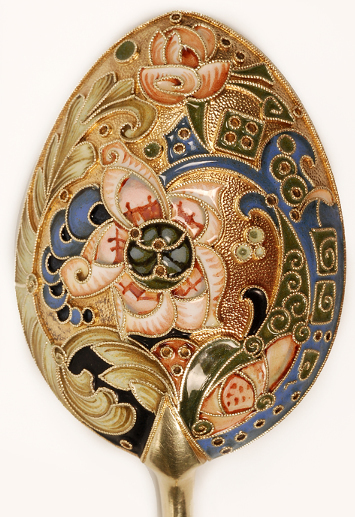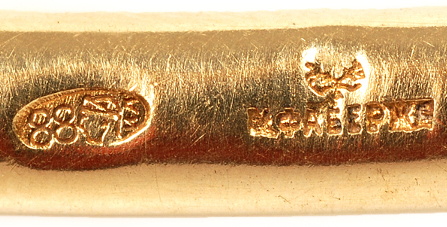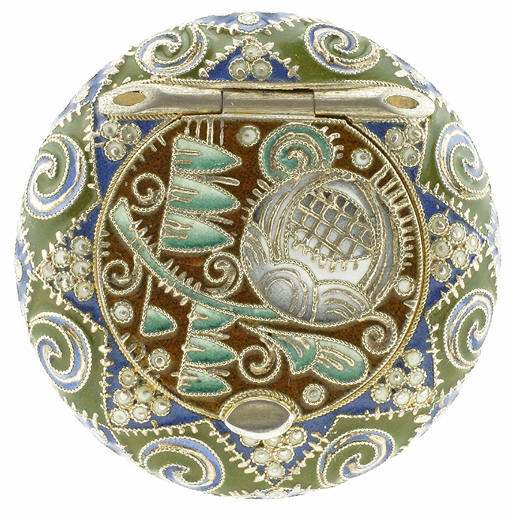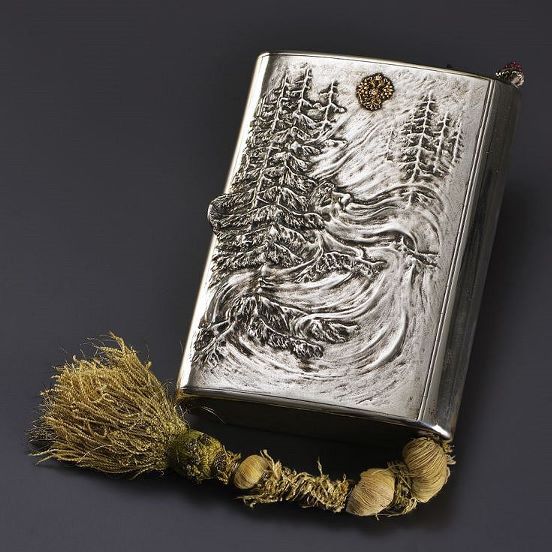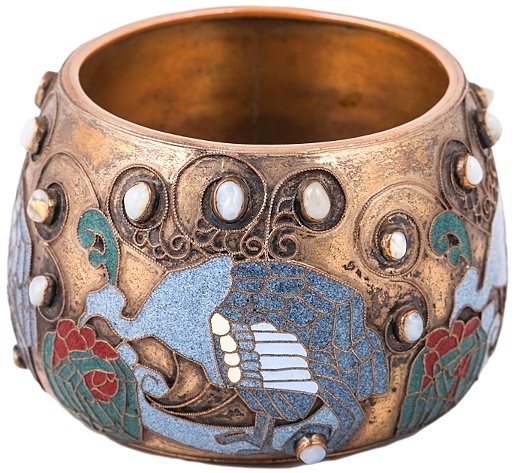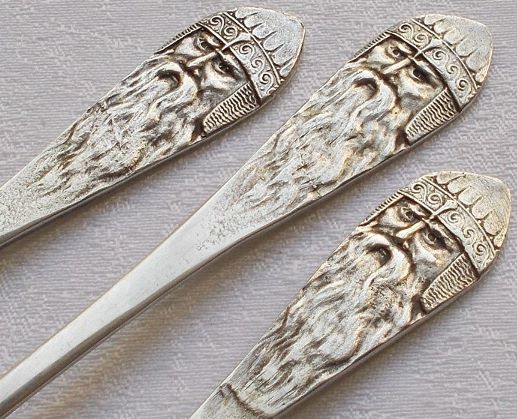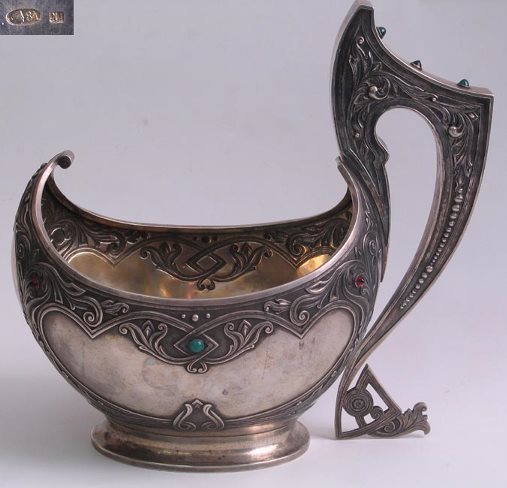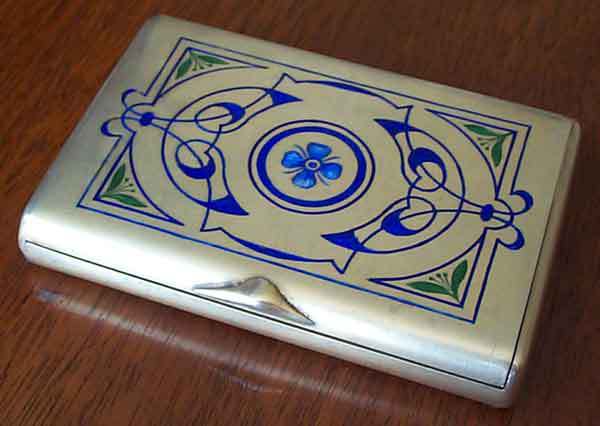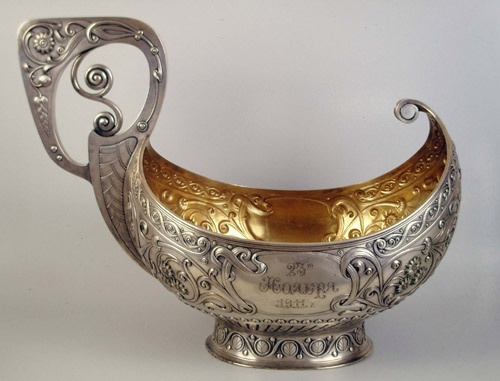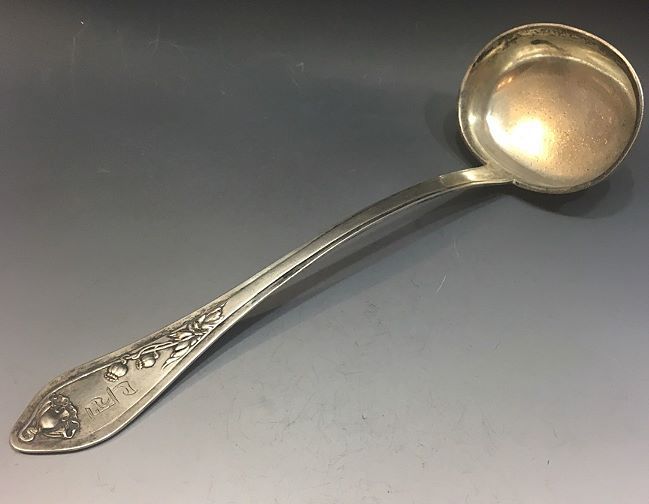Russian silver salt cellar
Re: Russian silver salt cellar
Goldstein, I think its not responsible to say that everything is fake because
The first role of every antiques collector or dealer is to always handle an item
Before you can say its fake or real in 100%, there are some items that looks completely fake
Like the lizard sculpture that was posted here that is mounted on Zaire malachite.
I just have to say I never said this item is by Stephan Wäkeva, I just asked who is the artist
And yes, I'm sure it is original , but still don't know who is the maker.
thank you all for the info you posted here
The first role of every antiques collector or dealer is to always handle an item
Before you can say its fake or real in 100%, there are some items that looks completely fake
Like the lizard sculpture that was posted here that is mounted on Zaire malachite.
I just have to say I never said this item is by Stephan Wäkeva, I just asked who is the artist
And yes, I'm sure it is original , but still don't know who is the maker.
thank you all for the info you posted here
Re: Russian silver salt cellar
Qrt.S -
it would not hurt if you read a little and understand about Art Deco what it exactly is - in Austria - Germany - France!
A fake is a fake even if the basis is authentic but the marks are later added....
My opinion: the object is original and authentic ( about 1920) - even the mark WS could be authentic (some Art Deco specialist may know the artist), because the letters W an S are in the typical Art Deco style.
The Kokoshnik came later by some forger - also a fake (Russian fake)!
I repeat for you: object probably original - Kokoshnik later by some forger - also a fake.
According to the kokoshnik mark the object must have been made between 1908 and 1917 - long before Art Deco in this pure form started.
By the way: I never have seen such pure hardcore art Deco in russian silver.
Goldstein
it would not hurt if you read a little and understand about Art Deco what it exactly is - in Austria - Germany - France!
A fake is a fake even if the basis is authentic but the marks are later added....
My opinion: the object is original and authentic ( about 1920) - even the mark WS could be authentic (some Art Deco specialist may know the artist), because the letters W an S are in the typical Art Deco style.
The Kokoshnik came later by some forger - also a fake (Russian fake)!
I repeat for you: object probably original - Kokoshnik later by some forger - also a fake.
According to the kokoshnik mark the object must have been made between 1908 and 1917 - long before Art Deco in this pure form started.
By the way: I never have seen such pure hardcore art Deco in russian silver.
Goldstein
Re: Russian silver salt cellar
I think that you Goldstein should do some reading for understanding Russian silver because this is made in pure slavic taste
and you will search "faberge slavic taste " you will see a lot more objects with the same type of design which is not Art Deco
It is more closer to art noveuo or Jugenstiel which were typically adorned late faberge objects as you can see if you will try
and research without saying everyone "experts" in aמ arrogant way, I believe that even you (the best expert) don't know everything
In Russian silver .
but again thank you for the help
and you will search "faberge slavic taste " you will see a lot more objects with the same type of design which is not Art Deco
It is more closer to art noveuo or Jugenstiel which were typically adorned late faberge objects as you can see if you will try
and research without saying everyone "experts" in aמ arrogant way, I believe that even you (the best expert) don't know everything
In Russian silver .
but again thank you for the help
Re: Russian silver salt cellar
Hi antiquv -
thanks for your efforts!
Now to judge serious one should see the marks to know the years, assay towns and makers.
As you certainly know:
Under the influence of v. a. By IS Aksakov and the publicist Mikhail Nikolayevich Katkov (* 1818, ✝ 1887) was the panslavism in Russia before the outbreak of the Russo-Turkish War in 1876/77 temporarily a dominant power of public opinion, in the 1880s, however, he was from » Pan-Russianism "replaced.
Regards
Goldstein
thanks for your efforts!
Now to judge serious one should see the marks to know the years, assay towns and makers.
As you certainly know:
Under the influence of v. a. By IS Aksakov and the publicist Mikhail Nikolayevich Katkov (* 1818, ✝ 1887) was the panslavism in Russia before the outbreak of the Russo-Turkish War in 1876/77 temporarily a dominant power of public opinion, in the 1880s, however, he was from » Pan-Russianism "replaced.
Regards
Goldstein
Re: Russian silver salt cellar
Art nouveau (стиль модерн) was not widely accepted and not very popular in Russia.More often seen in engraving than in casting.
Even in Western Europe, where it originated, there were well documented requests by retailers to not supply art nouveau, but instead Hanau style reproduction silver.
Besides, it`s good to remember internal decoration at the time was mostly the responsibility of women, and with due respect, their taste was more inclined to conservative,traditional styles (fact known among Loetz art glass collectors).
In this particular case, it`s really difficult to attribute the salt cellar with certainty to Russia.
Or genuine Jugendstil (not Art Deco, I think)``Russified`` with Kokoshnik ?
At least, we`ll have to wait for another ``MS`` to emerge.Until then, we can only speculate, and enthusiasm is not a method of sound judgement.
Regards
Even in Western Europe, where it originated, there were well documented requests by retailers to not supply art nouveau, but instead Hanau style reproduction silver.
Besides, it`s good to remember internal decoration at the time was mostly the responsibility of women, and with due respect, their taste was more inclined to conservative,traditional styles (fact known among Loetz art glass collectors).
In this particular case, it`s really difficult to attribute the salt cellar with certainty to Russia.
Or genuine Jugendstil (not Art Deco, I think)``Russified`` with Kokoshnik ?
At least, we`ll have to wait for another ``MS`` to emerge.Until then, we can only speculate, and enthusiasm is not a method of sound judgement.
Regards
Re: Russian silver salt cellar
@Goldstein
Since you are always so eager of teaching people here, I believe it is time for you to in turn learn something that seems to be unclear to you.
FYI!
Nobody has seen a Russian object made in art deco style. You see the art deco is dated to about 1925-1940. At that time there is no Russia anymore, hasn't been for a few years for known reasons. The salt cellar in question's style is more or less art nouveau/jugend, dated around 1890~1920. Below you can see two examples showing the difference in fonts. To the left an art nouveau font and to the right an art deco font...See the difference? And now compare the fonts to the font on salt cellar's mark, which one is it?


Since you are always so eager of teaching people here, I believe it is time for you to in turn learn something that seems to be unclear to you.
FYI!
Nobody has seen a Russian object made in art deco style. You see the art deco is dated to about 1925-1940. At that time there is no Russia anymore, hasn't been for a few years for known reasons. The salt cellar in question's style is more or less art nouveau/jugend, dated around 1890~1920. Below you can see two examples showing the difference in fonts. To the left an art nouveau font and to the right an art deco font...See the difference? And now compare the fonts to the font on salt cellar's mark, which one is it?


Re: Russian silver salt cellar
I was thinking that perhaps the castle on the lid could be identified, maybe that would help? :::
Re: Russian silver salt cellar
@Goldstein,
It is really time for you to learn the styles. The lighter, cigarette box and spoon stems with the varjag/viking you show 30.12. at 11.44 have noting to do with art deco. The motif is taken from the Russian world of fairytales. They are of an earlier age. In Russia a very popular theme at that time. You could call them national romantic style, but not art deco. The motif is closer to jugend than art deco ever, it comes much later as already told.
Happy New Year to you and all readers, questioners, contributors and of course the site manager.
Qrt.S
It is really time for you to learn the styles. The lighter, cigarette box and spoon stems with the varjag/viking you show 30.12. at 11.44 have noting to do with art deco. The motif is taken from the Russian world of fairytales. They are of an earlier age. In Russia a very popular theme at that time. You could call them national romantic style, but not art deco. The motif is closer to jugend than art deco ever, it comes much later as already told.
Happy New Year to you and all readers, questioners, contributors and of course the site manager.
Qrt.S
Re: Russian silver salt cellar
Hi Qrt.S -
The "viking" is a Bogatir....
I really like your often funny, dusty and/or off topic "I know everything better" contributions - they are rarely helpful - always personal - but mostly good for a hearty laugh. Please let them keep coming. Only recapitulating known facts is boring.
I count on you - do not disappoint me!
I wish you the very best from all my heart for the coming year.
Goldstein
Anyone who knows halfway about Russian silver knows that this is not a "lighter", but a cigarette box with match compartment and tindercord.Qrt.S wrote:It is really time for you to learn the styles. The lighter,....
The "viking" is a Bogatir....
I really like your often funny, dusty and/or off topic "I know everything better" contributions - they are rarely helpful - always personal - but mostly good for a hearty laugh. Please let them keep coming. Only recapitulating known facts is boring.
I count on you - do not disappoint me!
I wish you the very best from all my heart for the coming year.
Goldstein
Re: Russian silver salt cellar
Interesting statements by you. Ask yourself what is the tinder cord for? Isn't it to light e.g. a papirossi? In other words a "lighter". Sometimes I wonder who is the teacher but for the records. A bogatyr is a fictional epic character while a varjag/viking did exist in the old days. Anyway, rather difficult to tell which one of those the figure is. In general what difference does it make?
Re: Russian silver salt cellar
Hello everybody!
This maker's mark looks similar to the maker's mark of the newly found Faberge sculptor/silversmith Maximilian Sokolovskiy, firstly mentioned in Tatiana Muntian book Feodor Ruckert & Carl Faberge (2016).


In my opinion almost every item attributed to Maximilian Sokolovskiy is fake, but I'm not such a good expert to affirmatively say so.
Regards
This maker's mark looks similar to the maker's mark of the newly found Faberge sculptor/silversmith Maximilian Sokolovskiy, firstly mentioned in Tatiana Muntian book Feodor Ruckert & Carl Faberge (2016).


In my opinion almost every item attributed to Maximilian Sokolovskiy is fake, but I'm not such a good expert to affirmatively say so.
Regards
Re: Russian silver salt cellar
Hi artemko -
as mentioned at the beginning - a fake.
Regards
Goldstein
as mentioned at the beginning - a fake.
Regards
Goldstein
Re: Russian silver salt cellar
Maximilian Sokolovskij ???? Never heard of him and no trace of such a name in my books. Could you show an extract from the mentioned book, thank you.
Re: Russian silver salt cellar
Hi,
There was СОКОЛОВСКИЙ Мариам Наполеонович, влад. маст. зол. и сер. изд. 1913–1917: Переславская, д. 45.
(Skurlov)
Must be some misunderstanding and confusion with the name.Skurlov can be trusted, at least so far.
If interested in buying the book enter this into Google
Федор Рюкерт и Карл Фаберже Татьяна Мунтян
There was СОКОЛОВСКИЙ Мариам Наполеонович, влад. маст. зол. и сер. изд. 1913–1917: Переславская, д. 45.
(Skurlov)
Must be some misunderstanding and confusion with the name.Skurlov can be trusted, at least so far.
If interested in buying the book enter this into Google
Федор Рюкерт и Карл Фаберже Татьяна Мунтян
Re: Russian silver salt cellar
This is from the book mentioned above:
The mark is not shown but described as ‚‚MS‚‚ in Latin.
One of the artists-sculptors who brought new plastic principles to the silver production of Carl Faberge was M. Sokolovsky. His name is mentioned in a number of documents from the handwritten, printed and graphic collections department of the Moscow Kremlin Museums.
Judging by the name and surname, Marian Napoleon Sokolovsky was a Pole by birth, possibly a descendant of an ancient Polish family (Sokolowski). Obviously, the Latin letters "MS" were used in the mark in connection with its national identity. In the addressbook of the calendar "All Moscow", he appears as the owner of the art-silver workshop, living in Glinisti lane, 6. Production was located on Pereslavskaya street, 45, and was mentioned in the "Gold and silver products" of the same directory until 1917 .
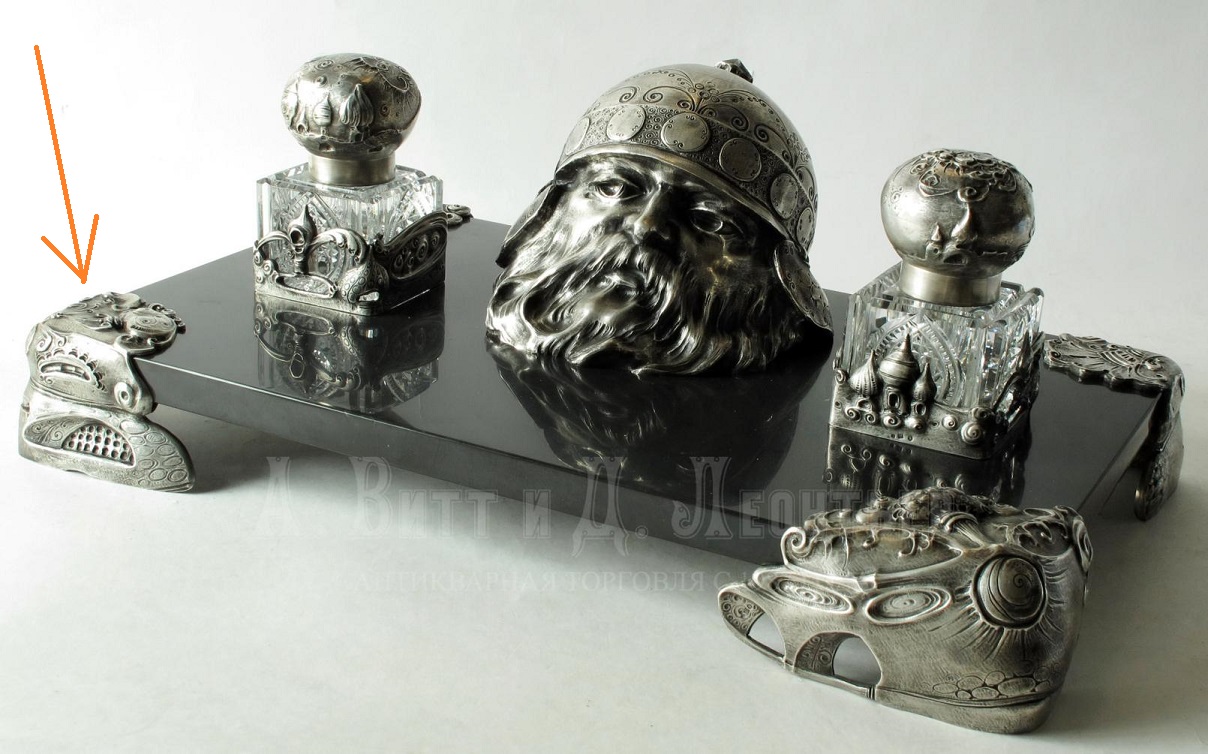
The mark is not shown but described as ‚‚MS‚‚ in Latin.
One of the artists-sculptors who brought new plastic principles to the silver production of Carl Faberge was M. Sokolovsky. His name is mentioned in a number of documents from the handwritten, printed and graphic collections department of the Moscow Kremlin Museums.
Judging by the name and surname, Marian Napoleon Sokolovsky was a Pole by birth, possibly a descendant of an ancient Polish family (Sokolowski). Obviously, the Latin letters "MS" were used in the mark in connection with its national identity. In the addressbook of the calendar "All Moscow", he appears as the owner of the art-silver workshop, living in Glinisti lane, 6. Production was located on Pereslavskaya street, 45, and was mentioned in the "Gold and silver products" of the same directory until 1917 .

